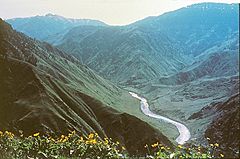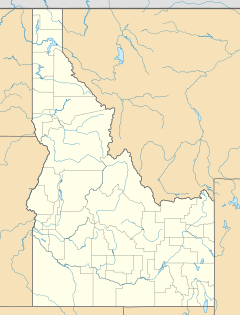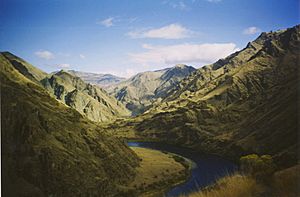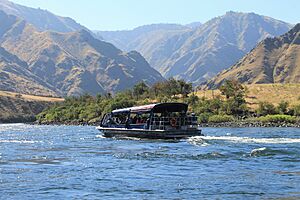Hells Canyon facts for kids
Quick facts for kids Hells Canyon |
|
|---|---|

Snake River flowing through the canyon
|
|
| Geography | |
| Country | United States |
| States | Idaho, Oregon, and Washington |
| County | Adams County, Idaho, Idaho County, Idaho, Wallowa County, Oregon, and Asotin County, Washington |
| River | Snake |
Hells Canyon is a huge canyon in the Western United States. It is about 10 miles (16 km) wide. You can find it where eastern Oregon, western Idaho, and a small part of eastern Washington meet.
This amazing place is part of the Hells Canyon National Recreation Area. It is also within the Wallowa-Whitman National Forest. Hells Canyon is North America's deepest river gorge. It is about 7,993 feet (2,436 meters) deep. This makes it even deeper than the famous Grand Canyon in Arizona.
The powerful Snake River carved out this canyon over many years. The river flows more than 1 mile (1.6 km) below the canyon's west rim in Oregon. On the east side, it flows 7,400 feet (2,256 meters) below the peaks of Idaho's Seven Devils Mountains. This wild area covers about 214,000 acres (86,600 hectares). Most of Hells Canyon cannot be reached by road.
Contents
Exploring Hells Canyon's Geology
The rocks in Hells Canyon tell a story that started 300 million years ago. Back then, a chain of volcanoes rose from the Pacific Ocean. Over millions of years, these volcanoes slowly sank. Then, limestone built up on the underwater platforms. The spaces between them filled with sedimentary rock.
Between 130 and 17 million years ago, the ocean plate carrying the volcanoes crashed into the North American continent. It became part of the land. After this, there was a lot of volcanic activity. Huge floods of basalt lava covered much of the area. This made the land smooth and flat, creating a high plateau.
The Snake River began carving Hells Canyon out of this plateau about 6 million years ago. Big changes to the canyon happened as recently as 15,000 years ago. This was during a massive flood from Glacial Lake Bonneville in Utah. Today, the canyon has thick forests, amazing viewpoints, and tall mountain peaks. At the very bottom, it is a dry, desert-like place.
A Look at Hells Canyon's Past
Early People of the Canyon
The first people known to live in Hells Canyon were the Nez Percé tribe. Other tribes also visited, like the Shoshone-Bannock, northern Paiute, and Cayuse Indians. They liked the mild winters and plenty of plants and animals. Pictographs and petroglyphs (rock carvings and paintings) on the canyon walls show where these early people lived.
In 1806, three members of the Lewis and Clark Expedition came close to Hells Canyon. They were exploring along the Salmon River. But they turned back before seeing the deepest parts of the canyon.
The Wilson Price Hunt expedition explored Hells Canyon in 1811. They were looking for a shortcut to the Columbia River. But hunger and cold forced them to turn back. Many other explorers also failed to get through the canyon because it was so hard to reach. There is no physical proof of their attempts in the canyon. Only their journals tell us about their journeys. Early explorers sometimes called this area Box Canyon or Snake River Canyon.
Miners and Settlers
Miners were the next to arrive. In the 1860s, gold was found in the river. Miners soon came into Hells Canyon. However, finding gold there was not very profitable. You can still see signs of their work along the Snake River. Later, people tried to mine for hard rock, which needed complex buildings. You can still see these old structures today, especially near the mouth of the Imnaha River.
In the 1880s, there was a short period when people tried to settle and farm the land. But the weather was not good for farming or ranching. Most settlers soon gave up. However, some ranchers still live and work within the Hells Canyon National Recreation Area.
In May 1887, a sad event happened. 34 Chinese gold miners were attacked and killed in the area. This event is known as the Hells Canyon Massacre. No one was ever held responsible for these deaths. Groups of white men attacked the Chinese miners because of strong anti-Chinese feelings that had spread to Oregon.
Building Dams on the Snake River
After big hydropower dams were built on the Columbia River from the 1930s to the 1950s, many groups wanted to build dams on the Snake River. This included a large dam in Hells Canyon. In 1955, the Federal Power Commission allowed the Idaho Power Company to build three dams in the canyon:
- The first dam, Brownlee Dam, was finished in 1960.
- Oxbow Dam, 12 miles (19 km) downstream, was finished in 1972.
- Hells Canyon Dam, 26 miles (42 km) below Oxbow, was finished in 1967.
These three dams together can produce 1,167 megawatts of electricity. This complex provides about 70 percent of Idaho's hydroelectricity. However, these dams block salmon and other anadromous fish (fish that swim upstream to lay eggs) from moving past Hells Canyon Dam.
Two more dams were planned in 1955. But the Wild and Scenic Rivers Act of 1968 stopped their progress. Later, during an energy crisis in 1975, the projects were brought up again. However, President Gerald Ford signed a law to create the Hells Canyon National Recreation Area. This stopped the dam projects for good.
The first people to go rafting on the canyon rapids were there by 1928.
Fun Activities in Hells Canyon
In 1975, Congress set aside 652,000 acres (264,000 hectares) as the Hells Canyon National Recreation Area. There are many fun things to do here! You can go fishing, take jet boat tours, hunt, hike, camp, and enjoy whitewater sports. These sports include rafting and kayaking.
Many of these activities depend on the mighty Snake River. The river is home to many kinds of fish. It also has many rapids, from easy to very challenging. Some of these are the biggest in the Pacific Northwest. The area has diverse wildlife and miles of trails. There is one boat ramp at the upper end of the Snake River.
Over 350 species of animals live here. This includes big game, small game, birds, and waterfowl for hunting. If you like trophy hunting, you might find elk, mountain goats, mountain lions, mule deer, whitetail deer, and black bears. All these things make Hells Canyon a popular outdoor recreation spot. Tourists come from all over the world to visit.
Hells Canyon offers tours all year round. Most whitewater activities are best in the summer months. You can join commercial tours or plan your own private trips to enjoy these activities.
How to Get to Hells Canyon
There are three roads that lead to the Snake River within Hells Canyon. They are located between Hells Canyon Dam and the Oregon-Washington state line. No roads actually cross Hells Canyon itself.
From Oxbow Bridge near Copperfield, Oregon, Hells Canyon Road follows the Idaho side of the river for 22 miles (35 km) downstream to the Hells Canyon Dam. The road then crosses the dam and continues for another mile to the Hells Canyon Visitor Center on the Oregon side.
Further north on the Idaho side, Deer Creek Road connects White Bird, Idaho, to the river at Pittsburg Landing. Near the northern end of the canyon, Forest Road 4260 (Lower Imnaha Road) reaches the river at Dug Bar. This last part of the road is very rough for most cars. Dug Bar is 21 miles (34 km) from Imnaha, Oregon.
If you want to see great views from the canyon rims, you can drive to viewpoints like Hat Point and Buckhorn in Oregon. In Idaho, you can visit Heavens Gate.






